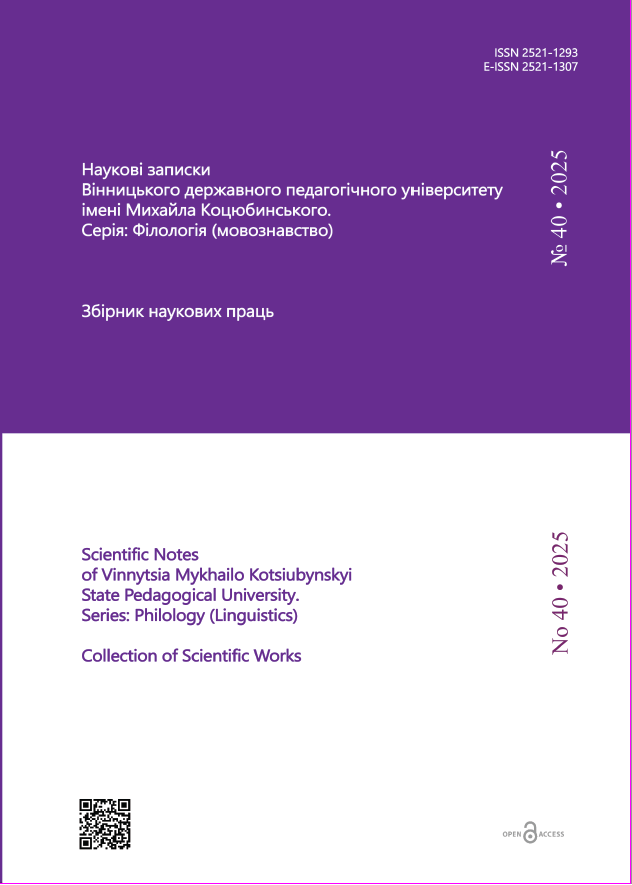Semantic-grammatical and pragma-stylistic functions of copulative propositional verbs in contemporary ukrainian media journalism
https://doi.org/10.31652/2521-1307-2025-40-08Published 2025-07-07
Keywords
- humorous culture, humorous discourse, comic effect, onyms, evaluation system, precedent phenomena, linguistic and cultural code

This work is licensed under a Creative Commons Attribution 4.0 International License.
How to Cite
Abstract
Among grammatical means (prepositions, conjunctions, copulas) that serve to connect words within a sentence or predicative parts of a complex sentence, the so-called copulative propositional verbs as full-fledged lexical units remain largely unexplored. These verbs function in the position of a predicative syntacteme within the semantic-syntactic structure of a simple sentence and, accordingly, as predicates at the formal-grammatical level, exhibiting the capacity to model propositional sentence structures. The article aims to conduct a comprehensive functional analysis of Ukrainian copulative propositional verbs in contemporary Ukrainian media journalism from semantic-grammatical and pragma-stylistic perspectives. To achieve this goal, the study employs various linguistic methods, including descriptive, structural, transformational, componential, and contextual-semantic analysis. The research is based on sentence constructions extracted from the online publication Ukrainska Pravda (2010–2024). Unlike copulative verbs that primarily serve syntactic functions, copulative propositional verbs carry a higher semantic load and demonstrate greater syntactic independence. Their valency capacity enables them to govern two syntactic positions— a left-branching subject position and a right-branching object position— which are predominantly occupied by abstract deverbal or deadjectival nouns. Each of these valency-driven substantives encapsulates a compressed elementary sentence, forming a separate proposition with its own subject-predicate semantic-syntactic structure. Copulative propositional verbs establish causal-resultative and conditional-resultative semantic-syntactic relations between two compressed propositions, often overlapping in function. The subject syntacteme incorporates the meaning of a cause or condition, whereas the object syntacteme conveys the consequence. At the formal-syntactic level of a simple sentence, the compressed subject assumes the syntactic role of the grammatical subject, while the compressed object occupies the position of a governed secondary clause element. The communicative (informational) structuring of such utterances is generally stable: the subject syntacteme serves as the theme, while the predicate and object syntactemes form a complex rheme. However, when the communicative goal is to emphasize the cause or condition underlying the extralinguistic situation condensed within the subject-causative syntacteme, this element shifts to the rheme position, with the object assuming the theme role. Originality. The study identifies the role and position of copulative propositional verbs within the broader system of copulative linguistic devices. It delineates the differential semantic-syntactic, formal-grammatical, and communicative parameters of these verbs. Furthermore, the research classifies copulative propositional verbs based on their capacity to establish semantic-syntactic relations and their functional load in utterances. The derivational base of sentences containing copulative predicates is also determined. Conclusion. Copulative propositional verbs form a peripheral category within the system of copulative means in the Ukrainian language, as they exhibit a limited lexical inventory and function under specific syntactic constraints, primarily expressing causative semantic relations. Nevertheless, they are actively employed across various functional styles of contemporary Ukrainian language, particularly in media journalism, where they enhance and condense causal-resultative and conditional-resultative logical connections between real-world events and phenomena within compact syntactic structures. Their derivational base consists of complex, information-dense sentences. The study highlights the necessity for further investigation into a broader range of copulative verbs across different linguistic registers.
Downloads
References
- Вихованець, І. Р. (1992). Нариси з функціонального синтаксису української мови : монографія. Київ : Наук. думка, 222 с.
- Вихованець, І. Р. (1980). Прийменникова система української мови : монографія. Київ : Наук. думка, 286 с.
- Вихованець, І. Р. & Городенська, К. Г. (2004). Теоретична морфологія української мови : Академічна граматика української мови; за ред. І. Р. Вихованця. Київ : Унів. вид-во «Пульсари», 400 с.
- Городенська К. Г. (2010). Сполучники української літературної мови : монографія. Київ : Інститут української мови; Видавничий дім Дмитра Бураго, 208 с.
- Іваницька, Н. Л. (2012). Докатегорійне – категорійне тлумачення ознаки автосемантизм / синсемантизм у сфері повнозначних слів української мови. Наукові записки Вінницького державного педагогічного університету ім. М. Коцюбинського. Філологія (мовознавство) : зб. наук. праць. Вінниця, вип. 15, с. 15–20.
- Масімова, Л. Г. (2012). Інтертекстуальність як особливість сучасного медіатексту (на прикладі аналізу публікацій газети «День»). Масова комунікація: історія, сьогодення, перспективи, № 1, с. 104–107.
- Межов, О. Г. (2012). Типологія мінімальних семантико-синтаксичних одиниць : монографія. Луцьк : Волин. нац. ун-т ім. Лесі Українки, 464 с.
- Слинько, І. І., Гуйванюк Н. В. & Кобилянська М. Ф. (1994). Синтаксис сучасної української мови: проблемні питання : навч. посіб. Київ : Вища шк., 670 с.
- СУМ – Словник української мови: в 11 т. Київ, 1970–1980





